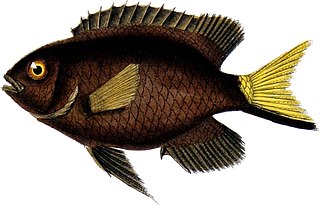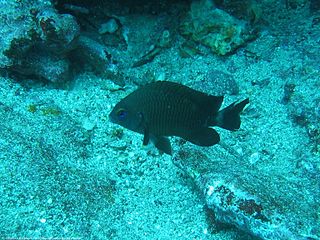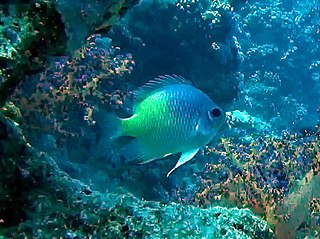
Aulostomus maculatus, the trumpetfish which is also known as the West Atlantic trumpetfish, is a long-bodied fish with an upturned mouth; it often swims vertically while trying to blend with vertical coral, such as sea rods, sea pens, and pipe sponges.

Stegastes is a genus of ray-finned fish in the family Pomacentridae. Members of this genus are marine coastal fishes except for S. otophorus, which also occurs in brackish water. These fish are known by the names of damselfish, gregory and major. They are small tropical fish associated with coral and rocky reefs in the Atlantic, Indian and Pacific Oceans. They are sometimes found in the aquarium trade where they are an easy-to-keep fish, but they do not mix well with other fish of their own or other species because of their territorial habits and aggressiveness.

Holacanthus bermudensis, the blue angelfish or Bermuda blue angelfish, is a species of marine ray-finned fish, a marine angelfish belonging to the family Pomacanthidae. It occurs in the western Atlantic Ocean.

The rock beauty, also known as corn sugar, coshubba, rock beasty, catalineta, and yellow nanny, is a species of marine ray-finned fish, a marine angelfish belonging to the family Pomacanthidae. It is found in the western Atlantic Ocean.

Stegastes nigricans, the dusky farmerfish, is a species of damselfish found around coral reefs at a depth of one to 12 meters, in tropical climates between 30°S and 30°N. They are known for farming monocultures of algae such as cyanophores and rhodophytes.

The Indo-Pacific sergeant (Abudefduf vaigiensis) may also be known as the Sergeant major although this name is usually reserved for the closely related species Abudefduf saxatilis.

Stegastes variabilis is a damselfish in the family Pomacentridae, found on coral and rocky reefs in the Caribbean Sea and neighboring areas of the Atlantic Ocean and Gulf of Mexico. They are often solitary fish.

Cephalopholis fulva, the coney or the butterfish, is a species of marine ray-finned fish, a grouper from the subfamily Epinephelinae which is in the family Serranidae which also includes the anthias and sea basses. It is found in the western Atlantic. It is associated with reefs and is a quarry species for commercial and recreational fisheries. It can be found in the aquarium trade.

Pomacentrus moluccensis, the lemon damselfish, is a species of bony fish in the family Pomacentridae, from the Western Pacific Ocean. It occasionally makes its way into the aquarium trade. It grows to a size of 9 cm (4 in) in length.

The longfin grouper, also known as the longfin rockcod, bar-breasted rock-cod, Gilbert's rock-cod, honeycomb rockcod, spotted groper or wirenet cod, is a species of marine ray-finned fish, a grouper from the subfamily Epinephelinae which is part of the family Serranidae, which also includes the anthias and sea basses. It is found in the Western Pacific Ocean.

Stegastes pictus, the yellowtip damselfish, is a species of damselfish found near the sea bed on shallow rocky reefs off the coast of Brazil, where it is endemic. It is a small, laterally-compressed, dark brown fish with yellow pectoral and caudal fins. It feeds on algae and detritus and is often found in the vicinity of the fire coral Millepora alcicornis. It is a territorial fish and forms a pair bond in the breeding season. The eggs are laid in a shallow scoop on the seabed and the male tends them to keep them well-aerated.

Stegastes leucostictus is a species of damselfish found near the sea bed in shallow waters on the western fringes of the Atlantic Ocean. It is commonly known as the beau gregory or beaugregory.

Stegastes fuscus, the dusky damselfish, is a species of bony fish in the family Pomacentridae found near the seabed in shallow waters on the western fringes of the Atlantic Ocean.

Stegastes partitus or the bicolor damselfish is a species of bony fish in the family Pomacentridae found near the sea bed on shallow rocky and coral reefs in the Caribbean Sea, the Gulf of Mexico and off the coasts of Florida.

The dark-banded fusilier, also known as blue-streak fusilier, bluedash fusilier, or neon fusilier, is a species of marine ray-finned fish, a fusilier belonging to the family Caesionidae. It has a wide Indo-West Pacific range. It is of some importance to fisheries within its range.

Apolemichthys trimaculatus, the threespot angelfish or flagfin angelfish, is a demersal marine ray-finned fish, a marine angelfish belonging to the family Pomacanthidae. It has a wide Indo-Pacific distribution.

Stegastes beebei, is a species of damselfish found on coral and rocky reefs at depths between 0 and 15 m. They are somewhat territorial, and chase away small intruders. They are omnivorous, grazing on algae and nibbling at small crustaceans and the tentacles of anemones. They are oviparous, with distinct pairing during breeding. The eggs are demersal and adhere to the substrate. Males guard and aerate the eggs.

The lunar fusilier, also known as the blue fusilier or moon fusilier, is a species of marine ray-finned fish, a fusilier belonging to the family Caesionidae. It is widespread throughout the tropical waters of the Indo-West Pacific area.

Neoglyphidodon thoracotaeniatus is a species of damselfish in the family Pomacentridae. It is found in the Indo-Pacific mainly in the Pacific Ocean. Adults can grow up to 13.5 centimetres (5.3 in). It is found in the aquarium trade.

Amblyglyphidodon flavilatus, known as yellow damselfish, yellowfin damselfish, yellow flank damselfish, yellow side damselfish, and yellow-sided Damselfish, is part Pomacentridae, which is a family of ray-finned fish including damselfish and clownfish. This family represents the greatest diversity and abundance of fish species inhabiting coral reefs. They were first discovered in the 1980s by Allen and Randall.




















